
Previous entry:
February 2008
Next Entry:
April 2008
Home:
One Truth For All
| Sun | Mon | Tue | Wed | Thu | Fri | Sat |
|---|---|---|---|---|---|---|
| 1 | 2 | 3 | 4 | 5 | ||
| 6 | 7 | 8 | 9 | 10 | 11 | 12 |
| 13 | 14 | 15 | 16 | 17 | 18 | 19 |
| 20 | 21 | 22 | 23 | 24 | 25 | 26 |
| 27 | 28 | 29 | 30 | 31 |
Archives
March 30, 2008
Swallowtail Shawl: Nupps Complete
This evening I got to the end of 20 rows of nupps. This was billed to me as being about 70 percent of the work on the Swallowtail Shawl, which it most definitely was not, in no small part because those nupps are in a sea of plain stockinette.
So here it is, now large enough that it can't be spread out on the needles I'm using (I guess I could swap out a larger cord, but I can't be bothered for only fifteen more rows of knitting).
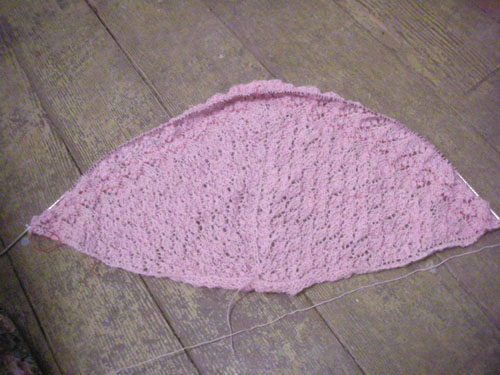
Technorati Tags: crafts, knitting, lace
I must say that the nupps are not terribly attractive right now. I know they will look substantially better after a nice wash and pin-out, but at the moment they look a little messy.
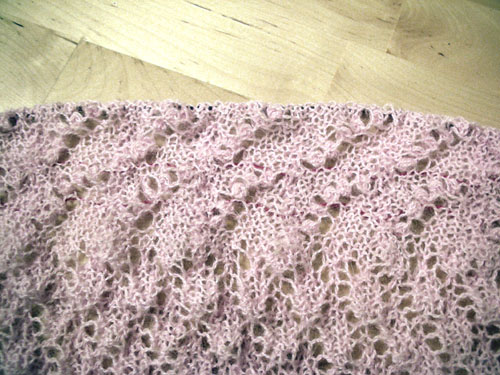
There are two rows of Lily of the Valley in this shawl, offset from each other. Now I have an edging pattern that is largely yarnovers and the occasional decrease, then a bind-off.
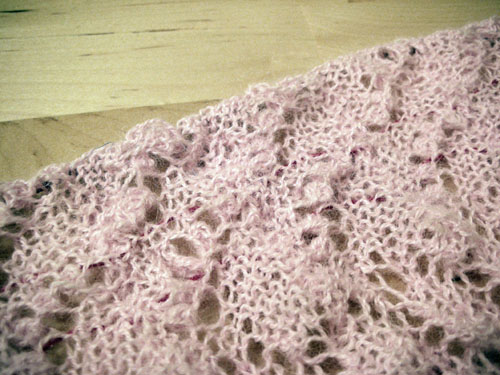
I think I will finish this shawl next week, which is a nice thing. If I'd sat down and worked on it every day this week, I would be done by now, but I would work on one row, then go do something else, then come back. And yet it has still gone every so much more quickly than the budding lace pattern at the beginning.
I'm actually rethinking another shawl pattern because of this. I'd been thinking of doing a shawl that is an all-over pattern much like budding lace, but if that sort of dense, repeating pattern is so easily messed up, then maybe making a substantially larger shawl that has nothing but that sort of pattern in it is not a good call for me. Or I could do it as penance.
# Posted by ayse on 03/30/08 at 11:41 PM | Comments (1)
March 28, 2008
Swallowtail Shawl: Nupps
I've finished the ninth row of the first Lily of the Valley chart on the shawl. I took some time and practise yarn and worked on the dreaded nupps for a bit. Because of that practise, I am not finding the Lily of the Valley pattern very complicated at all. It's mostly knit and purl, and the nupps are pretty obvious, so I hardly need to look at the pattern at all. Certainly I don't need to be as detailed about where I am in the pattern as on the budding lace, where I was always getting lost and having to go backwards to refind my spot.
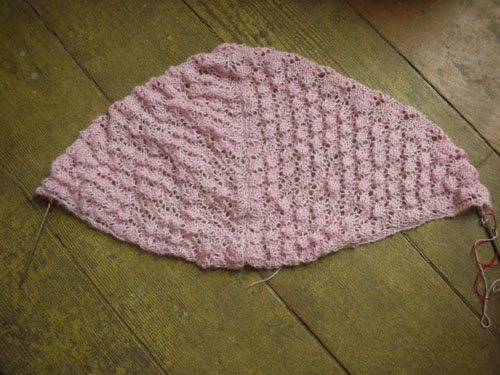
Technorati Tags: crafts, knitting, lace, nupps
Nupps, in case you did not know, are apparently from Estonian knitting, so it looks like this shawl would be good practise for a more complicated Estonian pattern. Here's the transition into the new chart from the budding lace, and you can see the nupps adding little punctuation marks in there.
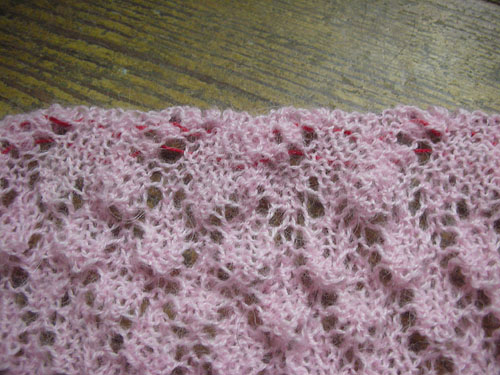
The pattern for a nupp is very simple, but practise is a bit more fiddly. On the knit side you k1, yo, k1, yo, k1 all into one stitch, to turn one stitch into five. On the purl side you have to p5 those five stitches together, and that is fiddly, because the needle doesn't want to go through that far. I followed a suggestion online and slid the piece down to work it over the cable of my circular needle, and that works really well.
So in fact this portion of the shawl is going much faster than the previous portion, even though it seems like much of the web is filled with people freaking out that the nupps are so difficult. You can't blaze through them, but they're more detailed than complicated.
Here I have a half-nupp (the red arrow at top) and completed nupp (the blue arrow). I spent a bit of time being super careful about lining the five stitches up nicely on the purl, before realizing it would all come out in a soak and block, anyway.
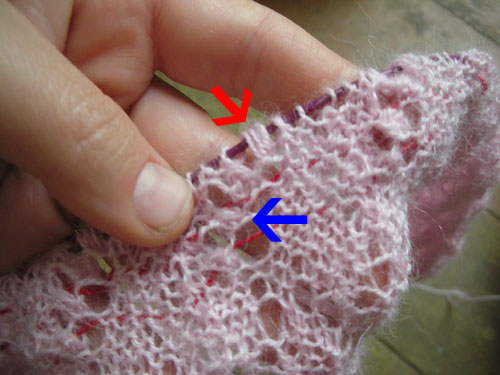
The one thing I think I could be doing much better on this is handling my tension. For some reason the first half of the nupps get very tight so I've been loosening up on my yarn, but that makes the final nupp very loopy. But, you know, first time nupper and all.
# Posted by ayse on 03/28/08 at 2:28 PM | Comments (0)
March 22, 2008
Swallowtail Shawl: End of Budding Lace
I just finished the budding lace pattern on the Swallowtail shawl, after much reknitting. (This would be a better picture but Rosie was very interested in the goings-on on the floor and kept shoving her face in the camera.)
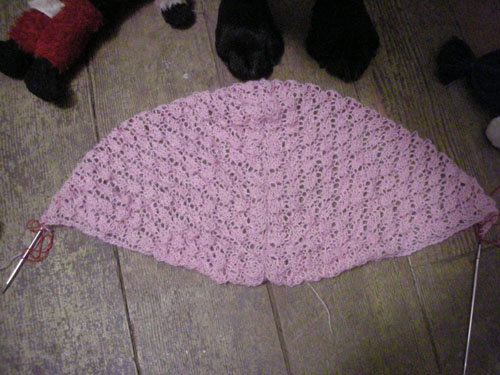
Now on to page 2 of the pattern. The part that's apparently difficult.
Technorati Tags: crafts, knitting, lace
# Posted by ayse on 03/22/08 at 10:32 PM | Comments (0)
March 21, 2008
Back to the Swallowtail
I recently went back to work on the Swallowtail Shawl, started over the summer even though it was patently obvious I would never have enough time to work on it when school restarted. I even underwent dramatic repairs to the completed portion, and then I was unhappy with the results and ripped it all out again.
I would probably make a lot more progress on this thing, a lot faster, if I were not such a perfectionist that messing up one stitch makes me rip back two or three repeats in frustration, or rip the whole thing out and restart. But lately I've been using lifelines to mark "known good" rows and thus control the extent of the ripping back, and that's made things much better (except for that one time when I managed to pull a bunch of stitches off the needle when putting in a lifeline, of course).
See:
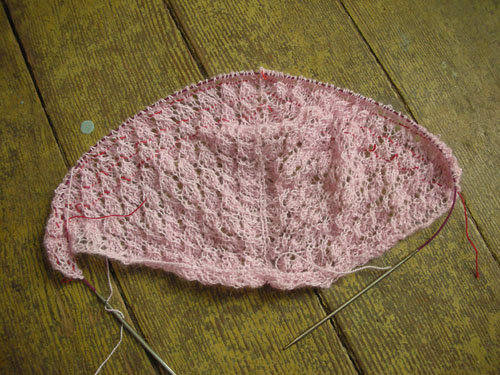
I'm on repeat 11 of 14 for the "budding lace 2" pattern. Apparently it gets much harder from here on in. I made the mistake of going to read the knitalong blog the other day, in which we see many knitters either knitting this thing very quickly (I just don't have that much time to knit), or totally freaking out about fairly simple things.
And here are my lifelines. I'm using one really long piece of string back and forth for the lifelines, so it's easier to manage if I leave it in for previous rows until I need more string.
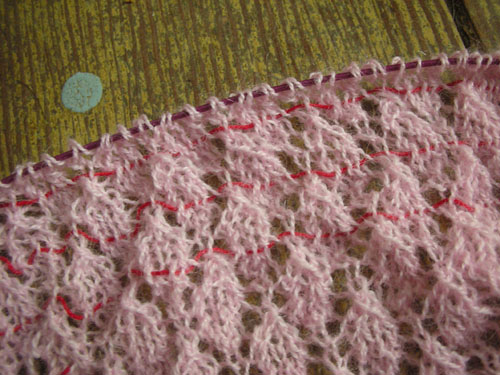
Technorati Tags: crafts, knitting, lace
# Posted by ayse on 03/21/08 at 1:41 PM | Comments (0)
March 14, 2008
An Evening with Temple Grandin
Last night Elaine and I went to see Temple Grandin talk at Las Positas College in Livermore. My main gripe with the talk was that it was held in the stupidest possible place for a talk: a gym, with a gym sound system. I could understand maybe half of every word Grandin said, which was pretty hard work. Next time try for an actual auditorium, guys.
Technorati Tags: brains
Grandin talked a great deal about what it was like to be autistic, and how she and other autistic people think. For one thing, she tends not to think in words, but in pictures: when trying to understand things, she is assembling collections of images and relating them to each other. Verbal language is not easy for her and is not how she thinks.
And she's also focusing on details, which she will assemble to create a bigger picture. Indeed, in response to a question, she explained that as she ages and accumulates more information, her ability to put things together gets better, because she has more information to work from in creating those bigger pictures. She reads a lot about a lot of different things.
Normal people tend to filter a lot of those details out of their minds: when she pictures a church steeple, she sees several very specific steeples. When a normal person pictures a church steeple they see a diagrammatic representation of a non-specific steeple. Autistic people are not very good are generalizations like that.
In addition, Grandin noted that her thinking is very associative, not linear. When somebody mentions a church steeple she will picture specific steeples and then move on to things those pictures remind her of in quick succession. And her brain works such that verbal problems have to be processed as visual problems, so there is a translation delay in her thinking when working directly with words. (She noted that her slide shows drive verbal people crazy because they are so associative and visual.)
Normal people, she noted, look around a lot. Autistic people tend to focus, and they tend to focus on things rather than people. Autistic people do not multitask.
She told us she groups autistic people into three groups:
1. Visual thinkers, who think in pictures, and are bad at very abstract things like algebra. This is how Grandin classes herself, and when she originally wrote her book Thinking in Pictures she thought this was the only way autistic people came.
2. Music and Math, or pattern thinkers. These people are very good at patterns and analysis.
3. Verbal Logicians, who are storehouses of data and factoids. These people are very bad at drawing because they cannot think visually.
One point Grandin made several times was that special education should be working with the autistic kids' talents, rather than hammering on their deficiencies. When an audience member asked about how to get her autistic kid to do school work in other areas than rockets, she suggested that he be told to read books about rockets, do math for rocketry, draw pictures of rockets. Take his interest and use that as a lever to make him do the kind of work he was not interested in.
In addition, she emphasized the importance of apprenticeships and career-focused learning for autistic kids. "Happy aspies have careers," she said, and they need structure and training to help them hold onto those careers. Indeed, a lot of strict social training is necessary so they learn what the rules are for being good citizens.
In talking about the structural differences between autistic brains and normal brains, she talked about the white matter in the brain, the interconnective tissue. Autism is basically a problem in the structure of that white matter: there's much more of it in certain areas and not enough in other areas. She also said that autistic people have immature lower brain areas and use their frontal cortex less than normal people.
There are some basic differences that come out of this: research has shown that language capacity covers up other areas of the brain, particularly visual and musical thinking. So when a lot of connective tissue is going to those visual areas of the brain they are overriding language.
In addition, Grandin explained that she has no subconscious: her cognitive processes all happen in her conscious mind. One of the beginnings of cognition is the "orienting response," the moment of orienting to a stimulus in order to make a decision about what to do with it. For normal people that happens subconsciously, but for her that is a conscious decision, which can be distracting.
Other distractions are hypersensitivities. High pitched sounds (like from PA systems, TVs, other electronic equipment) can be overwhelming, and auditory detail will be reduced so just hearing somebody talk is hard work. Flickering lights (fluourescents, TV screens, CRT monitors) can seem much more flickery.
Some suggestions she had for temper tantrums/issues in autistic kids:
- don't let them get overtired
- make sure they're not over-stimulated (rose coloured glasses help, incandescent lights, hats)
- make sure there is no medical problem (constipation, infection, toothache)
- get them lots of exercise
- try special diets (try for three months to be sure it's working, but no more if it doesn't)
- if you do use medication, use much much lower doses than normal; if a little bit is good, a lot will not be much better
- give strict rules and guidance for social behaviour
One question was about physical tics, and she said that tics should be left alone as long as they are not harmful, but there should be limits on when they can do them. So kids with tics should have a time when they can specifically go off and perform their tic, and times when they are absolutely not allowed to do it (like at the dinner table). The thing is, tics are calming for the kids, and in some cases they can help with auditory processing, so you definitely do not want to try to make them control the tic all the time if it is not harmful to anybody.
Lastly, one question that came up was about whether she thought autism was good or bad. Grandin noted that very social people tend to sit around being very social, while autistic/aspergers people tend to invent things and create things. So in many ways our culture is dependent on the spectrum for its technology. Removing it from the gene pool would be very complicated and would not be good for us. (Let's leave aside for the moment what on earth that guy was thinking to ask somebody if she thought her genetic stock should be removed from the gene pool. Kind of like asking a Jew if they thought the Holocaust was a good idea. Sheesh.)
# Posted by ayse on 03/14/08 at 2:27 PM | Comments (0)
March 1, 2008
Yarn and Fiber
I bought a bunch of skeined yarn recently, at Stitches West. In theory, I could just take the yarn to the yarn store and sit and wind it there: they're usually pretty good about that at midday during the week when there's nobody there. But I'd been planning to try to build a swift, so that is how I spent this afternoon:
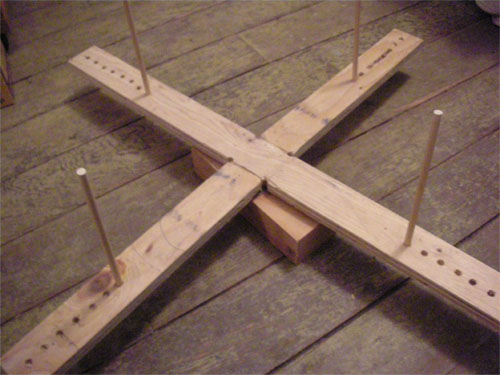
I call it the Sketchy Swift, because it's kind of sketchy. That's because the material I had on hand was some really horrible exterior-grade plywood left over from the foundation work. On the other hand, I spent $3 on a nice piece of lazy susan hardware (the only money I spent on this) so it rotates very nicely. I may rebuild the structure from nicer material at a later date. Maybe something that doesn't shatter when you drill holes in it.
Also, I may have lost my mind because I recently made a small purchase:
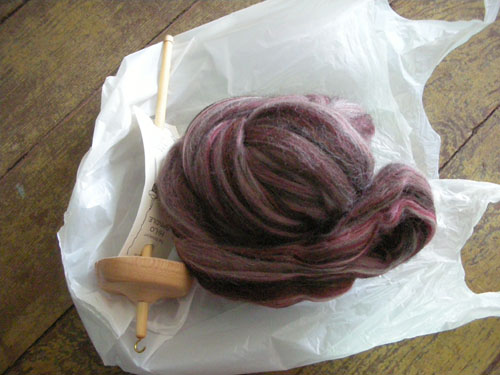
The last thing I need to do is pick up another hobby. Right? Well, we will see. Fortunately, spinning yarn is a pretty low-tech and cheap hobby if you want it to be.
Technorati Tags: spinning, yarn
# Posted by ayse on 03/01/08 at 6:47 PM | Comments (0)